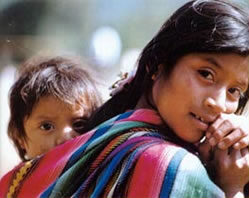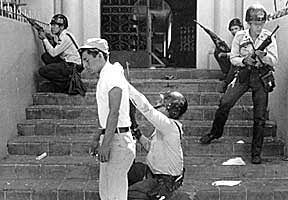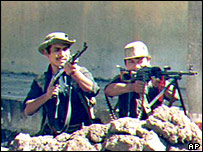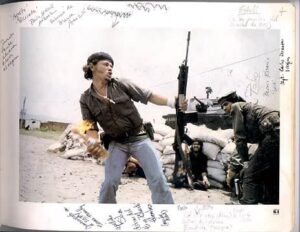History of Central American Revolutions
01:595:391 / 01:508:366




PURPOSE OF THIS COURSE
This course has three goals. First, we will briefly examine the history of Central America since the eigtheenth century and basic concepts in the study of revolt and revolution. Second, we will study the main themes in the history of Central America since the early twentieth century, especially those associated with the roots of the repressive states that took shape between the 1930s and 1960s and entered into crisis in the 1970s. Finally, we will study the history of the revolutionary processes of Guatemala, Nicaragua and El Salvador between the late 1970s and the early 1990s.
The revolutionary movements and civil wars that shook Central America in the 1980s defined the decade and led to a massive US direct, military and covert intervention in the region. Framed by some as a final battleground of the so-called cold war between the US and the Soviet Union, Central America scholars prefer to emphasize the complexity of internal social and political forces and the US’s traditional desire to control anti-capitalist and anti-authoritarian movements in its traditional ‘back yard.’ This course will allow students to examine the historical formation of three distinct militarized and anti-democratic states, the complex class, regional and racial tensions that constituted Central American societies, and the movements that challenged state, class and other hierarchies. At the end of the course we will consider the last 25 years or so of post-revolution states, migration to the US and the continued challanges to human rights and democracy in the region.
COURSE REQUIREMENTS
This is an advanced course and you will need to read and process about 100 pages of reading per week. This is a history course. Dates, places, names, individuals will matter to us greatly. Pay attention to these details as we go along. The syllabus will change somewhat as we advance through the semester. Sections marked with the red “new” icon ![]() will bring your attention to these changes. The readings and lectures will be the basis for your work. You need to do all the readings and bring notes and questions to each discussion session. I will lecture every Monday and we’ll have a more open discussion format on Wednesdays based on the lecture and the readings. You are expected to check your email regularly and learn how to use the SAKAI system.
will bring your attention to these changes. The readings and lectures will be the basis for your work. You need to do all the readings and bring notes and questions to each discussion session. I will lecture every Monday and we’ll have a more open discussion format on Wednesdays based on the lecture and the readings. You are expected to check your email regularly and learn how to use the SAKAI system.
- Determination of Grade:
- Class participation, presentation, attendance: 20%
- Weekly discussion papers: 20%
- Papers: 15% each (60% total)
- I follow the departmental grade curve linked here. Please note that an letter grade of A is from 93 to 100.
- Attendance:
- Attendance to all class sessions and consistent and effective participation in class discussions are required. Students frequently drop a whole grade in their final grades because of lack of participation and poor attendance.
- Discussion papers:
- You will have to hand in a one-page discussion of the readings on most Wednesdays. I will give you a questions for the first few weeks of these short reports.
- Papers:
- You will have four papers (6 pgs.)
- You are strongly encouraged to discuss your papers with me in office hours (before and after handing them in).
- Plagiarism is a serious breach of university policies. Make sure you know what it is. Papers copied from work done by others or cut and pasted from other sources will lead to an F and result in disciplinary action. Students often string notes taken from the readings word-by-word into their papers. This is also plagiarism.
BOOKS FOR THIS COURSE
The following books are required and should be ordered from any retailer. Other readings for this course are available on reserve on our sakai site.
- J. Gould and A. Lauria Santiago. To Rise in Darkness. Duke University Press.
- G. Grandin. The Last Colonial Massacre. University of Chicago Press.
- Russell Crandall. The Salvador Option: The United Statess in El Salvador. Cambridge University Press.
COURSE ORGANIZATION AND SCHEDULE:
Week 1: [9/5] Conceptualizing Revolt and Revolution/The Historical Geography of Central America/Colonial History
- Jeff Gould and Lowell Gudmundson. “Central American Historiography after the Violence,” Latin American Research Review, 32:1 (1997).
- John Booth. “Socioeconomic Roots of National Revolts in Central America,” Latin American Research Review, 26:1 (1991).
- Eric R. Wolf. “On Peasant Rebellions,” International Social Science Journal (1969)
- John Foran. “Theories of Revolution Revisited.” Sociological Theory 11:1 (March 1993), 1-20.
- William G. Roy. “Class Conflict and Social Change in Historical Perspective.” Annual Review of Sociology, Vol. 10. (1984), pp. 483-506.
- For Wed next week: In-class Map Exercise—identify all the principal countries, cities, and physical features of Central America [exercise will be done in class on a blank map] Use the following maps to prepare:
- Individual countries including some relief map
- Central American and the Caribbean—Political
- Perez Brignoli. Historical Atlas of Central America.
- Additional Links:
Week 2: [9/10 & 9/12] Geography, Demography and the Formation of a Colonial Region to 1820s
- Pearcy. The History of Central America. Chaps 1-3, 5.
- Hector Perez Brignoli. A Short History of Central America. Chaps. 2-3.
Week 3: [9/17 & 9/19] National States and Societies to 1830s to 1920s
- Lauria Santiago. An Agrarian Republic. Chaps. 3, 5.
- Read one of these three. Read two if you can, these are very interesting!
- Michel Gobat, Confronting the American Dream: Nicaragua under U.S. Imperial Rule, chaps. 1.
- Greg Grandin, The Blood of Guatemala: A History of Race and Nation, Chap. 5.
- Justin Wolfe—”Those That Live by the Work of Their Hands: Labour, Ethnicity and Nation-State Formation in Nicaragua, 1850–1900″
Week 4: [9/24 & 9/26] Imperialism, Caudillismo and Nationalism in Nicaragua, 1920s-1930s
- Michael J. Schroeder, “Horse Thieves to Rebels to Dogs: Political Gang Violence and the State in the Western Segovias, Nicaragua, in the Time of Sandino, 1926-1934,” Journal of Latin American Studies 28: 2 (1996).
- Jeffrey L. Gould. To Die in This Way: Nicaraguan Indians and the Myth of the Mestizaje 1880-1965. Chap 1.
- Skim: Lester Langley. The Banana Wars: United States Intervewntion in The Caribbean, 1898-1934. Chaps. 6, 14-16.
- Read one of these two:
- Michael J. Schroeder, “The Sandino Rebellion Revisited: Civil War Imperialism, Popular Nationalism and State Formation Muddled up Together in the Segovias of Nicaragua, 1926-1934” in Close Encounters of Empire: Writing the Cultural History of US-Latin American Relations. Gilbert Joseph, et. al. eds
- Michel Gobat, Confronting the American Dream: Nicaragua under U.S. Imperial Rule, chaps. 4,8.
Week 5: [10/1 & 10/3] Development and the Somozista State, 1940s-1960s
- 10/1 and 10/3: No meeting: Watch these:
- https://www.youtube.com/watch?v=9bqvLErbfKY
- While on the campus network (or connected via VPN): https://rutgers.primo.exlibrisgroup.com/view/action/uresolver.do?operation=resolveService&package_service_id=7199296840004646&institutionId=4646&customerId=4645
- One page discussion of videos: discuss how any of these themes are presented in the documentaries: communism, Nationalism, imperialism, somoza dictatorship, revolution. To the dropbox.
- One page discussion of readings: What were the sources of strength and stability in the Somoza family governments? To the dropbox.
- Knut Walter, The Regime of Anastasio Somozo, 1936-1956. Chaps. 4, 5. [Chap. 2 is optional-Traces early Somoza Govt in 1930s)
- Richard Grossman. “The Guardia Nacional”…
- Jeffrey L. Gould. To Lead as Equals. Chaps. 9, 12.
- Skim: Matilde Zimmerman, The Nicaraguan Revolution, A Brief History. p. 3-21.
Week 6: [10/8 & 10/10] Nicaragua: Sandinismo and the Sandinista Revolution, 1979-1990
- Matilde Zimmerman,.The Nicaraguan Revolution, A Brief History. Chaps. 4-6.
- Stahler Review Essay (very short)
- Chose from Martinez or Luciack articles (skim)
- Walker. Nicaragua. Selected passages in Sakai
- First Paper: First Paper due Monday Oct 15
Week 7: [10/15 & 10/17] Nicaragua: Demise of the Revolution and post-Revolutionary Period, 1990-2000
- William Walker. Nicaragua Without Ilussions: Regime Transition and the Structural Adjustment in the 1990s. Chaps 5,6,7,9, 10, 11,12,13,15.
- OPTIONAL but inspiring and insightful, short interviews:
- Denis Lynn Daly Heyck. Life Stories of the Nicaraguan Revolition. 27-137, 253-259.
Week 8: [10/22 & 10/24] Guatemala: Popular Movements, Reform, and Cold War Terror, 1944-1970
- Rachel May. Terror in the Countryside. Chap 4.
- Cindy Forster. The Time of Freedom: Campesino Workers in Guatemala’s October Revolution. Chap. 4 & 5.
- Greg Grandin. The Last Colonial Massacre. Intro, 1.
- Recommended:
- Stephen M. Streeter. Managing Counterrevolution: The United States & Guatemala, 1954-1961..
Week 9: [10/29 & 10/31] Guatemala: Urban Revolt, Rural Insurgency, Mass Repression, 1977-1990
- Rachel May. Terror in the Countryside. Chap 6-7.
- Greg Grandin, The Last Colonial Massacre, chaps. 3-5.
- Kristen Weld, The Archives of Dictatorship in Guatemala. Fragments.
- Optional but recommended:
- Robert Carmack, “The Story of Santa Cruz Quiché,” in Harvest of Violence: The Maya Indians and the Guatemalan Crisis. Robert M. Carmack, ed.
- Susan Jonas. The Battle For Guatemala: Rebels, Death Squads and US Power. Chaps 8-10.
- James Handy. Sea of Indians, Ethnic conflict Guatemalan Revolution.
- Second discussion paper: Due Sunday Nov 4 by midnight:
- Guatemala experienced a rare period of reform during the late 1940s and 1950s. Do you think this earlier experience made the state and elite’s response to demands for change in the late 1970s more violent and rigid? Or is the longer-term character of Guatemalan society the critical piece that conditioned the state’s response? Discuss with evidence. Same rules. Six pages. More pages ok. References in simple form in footnotes. To dropbox.
Week 10: [11/5 & 11/7] El Salvador: The 1932 Peasant Revolt and Massacre
- J. Gould and A. Lauria Santiago. To Rise in Darkness. Chaps. 1-6.
- Cicatriz de la Memoria (video)—Will be on Sakai and in-class
- Documents:
Week 11: [11/12 & 11/14] El Salvador: Development and the Military State, 1950-1970s
- William Stanley, The Protection Racket State: Elite Politics, Military Extortion and Civil War in El Salvador, pgs. 58-106. Chap. 4.
- Knut Walter & Philip Williams. The Military and Democratization in El Salvador, chap. 5-6.
- Optional:
- John Coatsworth. Central America and the US: The Clients and the Colossus, chap 6.
- Leigh Binford. The El Mozote Massacre. Chaps 2, 4-5.
Week 12: [11/19] El Salvador: Origins of Crisis, 1976-1980
- Paul D. Almeida. Waves of Protest: Popular Struggles in El Salvador, 1925-2005. Chap 4.
- Russel Crandal. The Salvador Option. 8-18.
- Optional:
- Joaquín Mauricio Chávez. Poets and Prophets of the Resistance: Intellectuals and the Origins of El Salvador’s Civil War.
Week 13: [11/26 & 11/28] El Salvador: Revolution, Civil War and Resolution, 1981-1992
- Leigh Binford. The El Mozote Massacre. Chaps 6-7.
- Russel Crandal. The Salvador Option. 19-38.
- “Revolutionary Power and a Divided State: The Positions of the National Army for Democracy at the End of the Salvadoran Civil War,” in Mapping Latin America: Space and Society, 1492-2000, Ed. Karl Offen and Jordana Dym.
- Third discussion paper: Due Sunday Dec 3 by midnight
- Discuss the sources and origins of El Salvador’s revolutionary conflict. Why did El Salvador experience a strong insurgency and popular revolutionary movement during the late 1970s and 1980s? How did demands for reform connect (or not) to revolutionary action? Who were the protagonists of these movements, what motivated them and were they able to transform El Salvador’s society and politics?
Week 14: [12/3 & 12/5] El Salvador: Post-war Realities, Defeats, Peace, Elected Governance, Social Violence
- Russel Crandal. The Salvador Option. Chaps. 46-48.
- Ralph Sprenkels. After Insurgency. Chaps 3-6.
- Optional:
- Knut Walter & Philip Williams, The Military and Democratization in El Salvador. Chap 7.
- Patricia Ardon, Deborah Eade, Post-War Reconstruction in Central America: Lessons from El Salvador, Guatemala and Nicaragua.
- Nelson and Mcalliseter. War by other means. aftermath in post genocide Guatemala.
Week 15: [12/10 & 12/12] Central America: Post-war Realities, Migration and Diaspora in the US
- Cecilia Menjivar. “Liminal Legality: Salvadoran and Guatemalan Immigrants’ Lives in the United States.” American Journal of Sociology 111:4. 2006.
- Cecilia Menjivar. “The power of the law: Central Americans’ legality and everyday life in Phoenix, Arizona.” Latino Studies 9:4 2011.
- Cecilvar. “The Intersection of Work and Gender: Central American Immigrant Women and Employment in California. American Behavioral Scientist 42 199